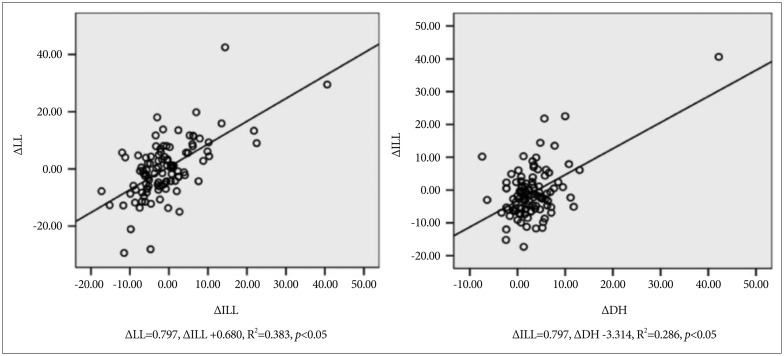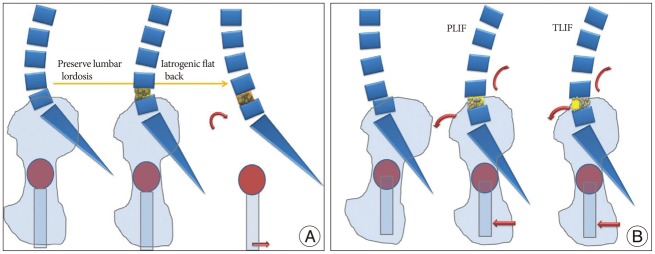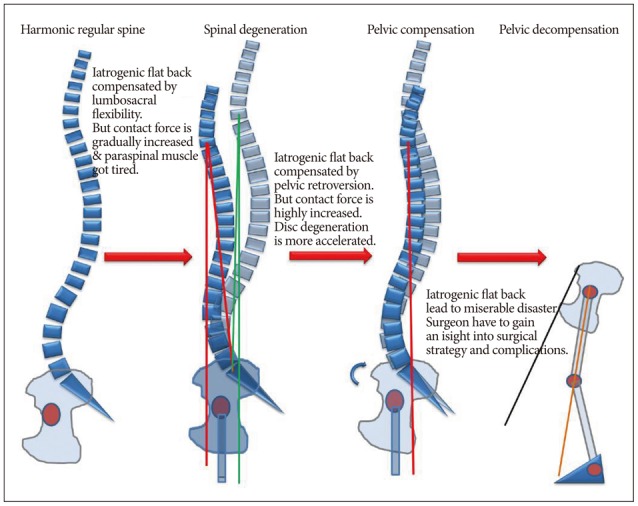J Korean Neurosurg Soc.
2014 Oct;56(4):315-322. 10.3340/jkns.2014.56.4.315.
Postoperative Flat Back: Contribution of Posterior Accessed Lumbar Interbody Fusion and Spinopelvic Parameters
- Affiliations
-
- 1Department of Neurosurgery, Eulji General Hospital, College of Medicine, Eulji University, Seoul, Korea. nsdrmbg@hanmail.net
- KMID: 2018082
- DOI: http://doi.org/10.3340/jkns.2014.56.4.315
Abstract
OBJECTIVE
Posterior accessed lumbar interbody fusion (PALIF) has a clear objective to restore disc height and spinal alignment but surgeons may occasionally face the converse situation and lose lumbar lordosis. We analyzed retrospective data for factors contributing to a postoperative flat back.
METHODS
A total of 105 patients who underwent PALIF for spondylolisthesis and stenosis were enrolled. The patients were divided according to surgical type [posterior lumbar inter body fusion (PLIF) vs. unilateral transforaminal lumbar interbody fusion (TLIF)], number of levels (single vs. multiple), and diagnosis (spondylolisthesis vs. stenosis). We measured perioperative index level lordosis, lumbar lordosis, pelvic tilt, sacral slope, pelvic incidence, and disc height in standing lateral radiographs. The change and variance in each parameter and comparative group were analyzed with the paired and Student t-test (p<0.05), correlation coefficient, and regression analysis.
RESULTS
A significant perioperative reduction was observed in index-level lordosis following TLIF at the single level and in patients with spondylolisthesis (p=0.002, p=0.005). Pelvic tilt and sacral slope were significantly restored following PLIF multilevel surgery (p=0.009, p=0.003). Sacral slope variance was highly sensitive to perioperative variance of index level lordosis in high sacral sloped pelvis. Perioperative variance of index level lordosis was positively correlated with disc height variance (R2=0.286, p=0.0005).
CONCLUSION
Unilateral TLIF has the potential to cause postoperative flat back. PLIF is more reliable than unilateral TLIF to restore spinopelvic parameters following multilevel surgery and spondylolisthesis. A high sacral sloped pelvis is more vulnerable to PALIF in terms of a postoperative flat back.
MeSH Terms
Figure
Reference
-
1. Barrey C, Jund J, Perrin G, Roussouly P. Spinopelvic alignment of patients with degenerative spondylolisthesis. Neurosurgery. 2007; 61:981–986. discussion 986. PMID: 18091275.
Article2. Barrey C, Roussouly P, Perrin G, Le Huec JC. Sagittal balance disorders in severe degenerative spine. Can we identify the compensatory mechanisms? Eur Spine J. 2011; 20(Suppl 5):626–633. PMID: 21796393.
Article3. Bourghli A, Aunoble S, Reebye O, Le Huec JC. Correlation of clinical outcome and spinopelvic sagittal alignment after surgical treatment of low-grade isthmic spondylolisthesis. Eur Spine J. 2011; 20(Suppl 5):663–668. PMID: 21809014.
Article4. Chaléat-Valayer E, Mac-Thiong JM, Paquet J, Berthonnaud E, Siani F, Roussouly P. Sagittal spino-pelvic alignment in chronic low back pain. Eur Spine J. 2011; 20(Suppl 5):634–640. PMID: 21870097.
Article5. Cole CD, McCall TD, Schmidt MH, Dailey AT. Comparison of low back fusion techniques : transforaminal lumbar interbody fusion (TLIF) or posterior lumbar interbody fusion (PLIF) approaches. Curr Rev Musculoskelet Med. 2009; 2:118–126. PMID: 19468868.
Article6. Farcy JP, Schwab FJ. Management of flatback and related kyphotic decompensation syndromes. Spine (Phila Pa 1976). 1997; 22:2452–2457. PMID: 9355229.
Article7. Herkowitz HN, Kurz LT. Degenerative lumbar spondylolisthesis with spinal stenosis. A prospective study comparing decompression with decompression and intertransverse process arthrodesis. J Bone Joint Surg Am. 1991; 73:802–808. PMID: 2071615.
Article8. Kim CH, Gill SB, Jung MH, Jang YK, Kim SS. Clinical comparison of posterolateral fusion with posterior lumbar interbody fusion. J Korean Neurosurg Soc. 2006; 40:84–89.9. Kim YT, Lee CS, Na HY, Lee CW. A comparison of surgical treatment in isthmic and degenerative spondylolisthesis. J Korean Orthop Assoc. 1998; 33:1627–1634.
Article10. Labelle H, Mac-Thiong JM, Roussouly P. Spino-pelvic sagittal balance of spondylolisthesis : a review and classification. Eur Spine J. 2011; 20(Suppl 5):641–646. PMID: 21809015.
Article11. Lagrone MO, Bradford DS, Moe JH, Lonstein JE, Winter RB, Ogilvie JW. Treatment of symptomatic flatback after spinal fusion. J Bone Joint Surg Am. 1988; 70:569–580. PMID: 3356724.
Article12. Lazennec JY, Brusson A, Rousseau MA. Hip-spine relations and sagittal balance clinical consequences. Eur Spine J. 2011; 20(Suppl 5):686–698. PMID: 21796392.
Article13. Lazennec JY, Ramaré S, Arafati N, Laudet CG, Gorin M, Roger B, et al. Sagittal alignment in lumbosacral fusion : relations between radiological parameters and pain. Eur Spine J. 2000; 9:47–55. PMID: 10766077.
Article14. Le Huec JC, Aunoble S, Philippe L, Nicolas P. Pelvic parameters : origin and significance. Eur Spine J. 2011; 20(Suppl 5):564–571. PMID: 21830079.15. Le Huec JC, Charosky S, Barrey C, Rigal J, Aunoble S. Sagittal imbalance cascade for simple degenerative spine and consequences : algorithm of decision for appropriate treatment. Eur Spine J. 2011; 20(Suppl 5):699–703. PMID: 21811823.
Article16. Le Huec JC, Leijssen P, Duarte M, Aunoble S. Thoracolumbar imbalance analysis for osteotomy planification using a new method : FBI technique. Eur Spine J. 2011; 20(Suppl 5):669–680. PMID: 21818597.
Article17. Le Huec JC, Roussouly P. Sagittal spino-pelvic balance is a crucial analysis for normal and degenerative spine. Eur Spine J. 2011; 20(Suppl 5):556–557. PMID: 21811822.
Article18. Lombardi JS, Wiltse LL, Reynolds J, Widell EH, Spencer C 3rd. Treatment of degenerative spondylolisthesis. Spine (Phila Pa 1976). 1985; 10:821–827. PMID: 4089657.
Article19. Mac-Thiong JM, Roussouly P, Berthonnaud E, Guigui P. Age- and sex-related variations in sagittal sacropelvic morphology and balance in asymptomatic adults. Eur Spine J. 20(Suppl 5):2011; 572–577. PMID: 21833574.
Article20. Morvan G, Mathieu P, Vuillemin V, Guerini H, Bossard P, Zeitoun F, et al. Standardized way for imaging of the sagittal spinal balance. Eur Spine J. 2011; 20(Suppl 5):602–608. PMID: 21830081.
Article21. Obeid I, Hauger O, Aunoble S, Bourghli A, Pellet N, Vital JM. Global analysis of sagittal spinal alignment in major deformities : correlation between lack of lumbar lordosis and flexion of the knee. Eur Spine J. 2011; 20(Suppl 5):681–685. PMID: 21870096.
Article22. Pellet N, Aunoble S, Meyrat R, Rigal J, Le Huec JC. Sagittal balance parameters influence indications for lumbar disc arthroplasty or ALIF. Eur Spine J. 2011; 20(Suppl 5):647–662. PMID: 21845396.
Article23. Roussouly P, Pinheiro-Franco JL. Sagittal parameters of the spine : biomechanical approach. Eur Spine J. 2011; 20(Suppl 5):578–585. PMID: 21796394.
Article24. Sergides IG, McCombe PF, White G, Mokhtar S, Sears WR. Lumbo-pelvic lordosis and the pelvic radius technique in the assessment of spinal sagittal balance : strengths and caveats. Eur Spine J. 2011; 20(Suppl 5):591–601. PMID: 21863464.
Article25. Suk KS, Jeon CH, Lee HM, Kim NH, Kim HC. Comparison between posterolateral fusion with pedicle screw fixation and anterior interbody fusion with pedicle screw fixation in spondylolytic spondylolisthesis of the lumbar spine. J Korean Soc Spine Surg. 1999; 6:397–406.
- Full Text Links
- Actions
-
Cited
- CITED
-
- Close
- Share
- Similar articles
-
- The Result of Minimal Invasive Anterior Lumbar Interbody Fusion with Posterior Lumbar Interbody Fusion on Degenerative Lumbar Flat Back Disease
- Clinical Comparison between Decompression and Posterior Lumbar Interbody Fusion in Chronic Lower Back Pain Involving Degenerative Disc Disease and Spinal Stenosis
- Posterior Lumbar Interbody Fusion
- Posterior Lumbar Interbody Fusion
- Factors Affecting Incomplete L5/S Posterior Lumbar Interbody Fusion, Including Spinopelvic Sagittal Parameters





